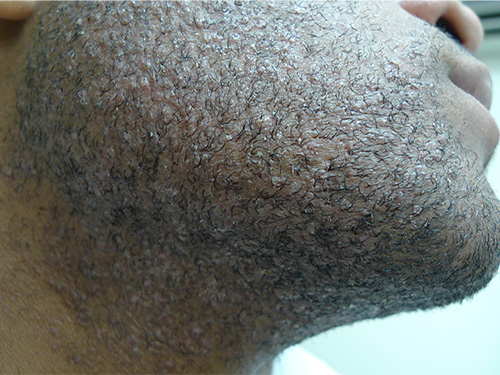Pseudofolliculitis
Pseudofolliculitis (also known as razor bumps or shaving rash) is a chronic inflammatory disorder caused by a foreign-body reaction to the hair shaft. It is not an infection, but it is a complication of hair removal techniques. It occurs when short, freshly cut hairs retract into the follicle and penetrate the side wall. It typically occurs on the face and neck of patients who shave (known as pseudofolliculitis barbae; see here for photo)British Association of Dermatologists, 2021, but can also develop on the upper thighs and groin as a result of bikini line waxing or shaving. It is more likely to occur in patients with curly hairBritish Association of Dermatologists, 2021.

Permanently stopping shaving or waxing is the best treatment for pseudofolliculitis, but may not be feasible. If stopping shaving or waxing is not feasible, treatment aims to improve the cosmetic appearance of the affected area. Adjusting shaving technique may help (eg washing the skin with warm water and soap-free cleanser before shaving, shaving with a clean sharp razor on relaxed skin [ie not pulling the skin taut]). For the bikini line and legs, shaving instead of waxing is often effective.
Laser hair reduction is an alternative to shaving or waxing but must be tailored to the patient’s skin type. It is most effective in people with pigmented hair and fair skin types. Laser therapy should be used with caution in people with darker skin types (eg Fitzpatrick skin types V and VI1) because of the risk of burns.
If treatment is needed for pseudofolliculitis, use:
benzoyl peroxide 5% gel or solution topically, twice daily. benzoyl peroxide benzoyl peroxide benzoyl peroxide
Response may take up to 6 weeks. If there is no response, add clindamycin. Use:
benzoyl peroxide+clindamycin 5%+1% gel topically, once daily. benzoyl peroxide + clindamycin benzoyl peroxide+clindamycin benzoyl peroxide+clindamycin
